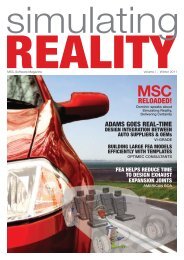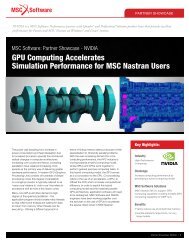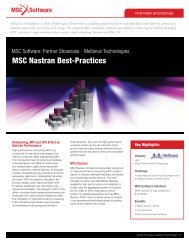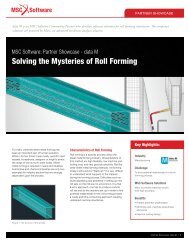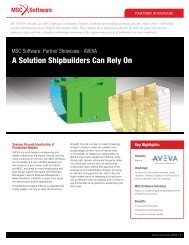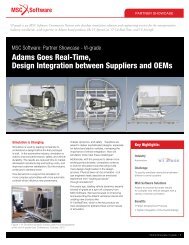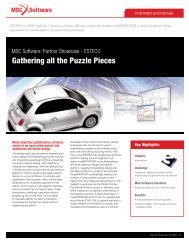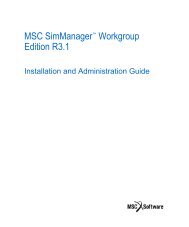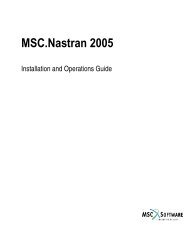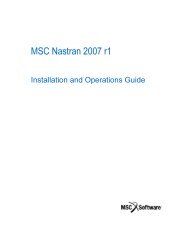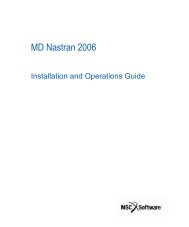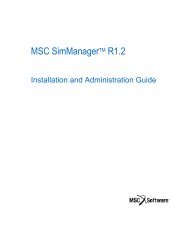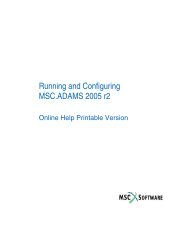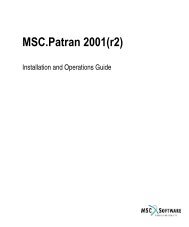Proton Success Story - MSC Software
Proton Success Story - MSC Software
Proton Success Story - MSC Software
Create successful ePaper yourself
Turn your PDF publications into a flip-book with our unique Google optimized e-Paper software.
<strong>MSC</strong>.<strong>Software</strong>: User Case Study - <strong>Proton</strong><br />
PROTON<br />
Customer Profile: Noor Hisham Bin Ismail<br />
Mr Noor Hisham Bin Ismail is head of CAE at PROTON based in Kuala Lumpur,<br />
Malaysia. Mr Ismail and other members of the computer-aided engineering team<br />
are responsible for improving the virtual development of mechanical and structural<br />
components, sub systems and complete vehicle system at PROTON. Through<br />
Mr Ismail’s innovative process of probabilistic analysis, PROTON has been able<br />
to effectively identify areas of high-risk failure and fine-tuning engineering design<br />
alternatives.<br />
Challenge<br />
In developing complex mechanical and structural automotive<br />
components, going through multiple build-and-test hardware prototype<br />
cycles to verify performance, stress and fatigue life is just too timeconsuming<br />
and expensive. This issue can be addressed by evaluating<br />
and refining designs with analysis tools up front in development, reducing<br />
test cycles later in the development process. PROTON’s pioneering spirit<br />
naturally has led Mr ismail to not just stop at traditional methodologies in<br />
computer-aided engineering for design analysis. As the risk of failure in<br />
any design was becoming<br />
more and more significant<br />
and he was constantly<br />
looking at areas to assess<br />
risk parameters and minimize<br />
any risk factors, he needed<br />
to turn to industry-leading<br />
simulation analysis tools that<br />
would be able to provide him<br />
with the necessary accurate<br />
foundation to progress his<br />
methodology. Mr Ismail<br />
Basic Stress and Material Cyclic Strength<br />
realized that conventional<br />
virtual development approaches are no longer sufficient to meet the<br />
increasing standards of accuracy required at PROTON. Conventional<br />
approaches do not take into consideration the variations that affect finite<br />
element analyses. Mr Ismail needed proven tools that produced the most<br />
accurate results, allowing him to capture the potential failures and provide<br />
the nature of failures so that these can be mitigated in the process. With<br />
resource efficiency on his mind, Ms Ismail also needed to manage test<br />
accuracy while reducing the dependency on running too many variations.<br />
Solution<br />
<strong>MSC</strong> FEA (<strong>MSC</strong> Nastran and Patran),<strong>MSC</strong> Adams.<br />
Benefits<br />
• Visible quantification of design risk or reliability<br />
• Identifies areas of high risk in a design<br />
• Provides the ability to modify design variables relative to reliability<br />
• Provides a means to compare differing designs<br />
Case Study<br />
PROTON can shorten the time-to-market by getting designs right the first<br />
time. Many of PROTON’s automotive components need extensive lead<br />
times because of its strict adherence to safety and quality standards.<br />
Besides, traditional physical testing can take weeks or even months to<br />
validate a design. Leveraging analysis early in the process can eliminate<br />
unforeseen changes and repetition of lengthy test cycles, providing<br />
significant reductions in overall development time.<br />
USER CASE STUDY<br />
Mr Ismail’s foundation of probabilistic design methodology uses design<br />
criteria based on reliability targets instead of deterministic criteria.<br />
First, design parameters such as applied loads, material strength, and<br />
operational parameters are researched and/or measured and then<br />
statistically defined. A probabilistic analysis model is then developed for<br />
the entire system and solutions performed to yield failure probabilities.<br />
With <strong>MSC</strong>’s FEA, applied stress is obtained from finite element models.<br />
The general concept is to integrate the joint probability of applied stress<br />
and material strength over the region where stress exceeds strength. The<br />
result of the integration is the probability of structural failure and this helps<br />
to provide the necessary information for sensitivity analysis and design<br />
optimization.<br />
Relying on industryleading<br />
solutions such<br />
as <strong>MSC</strong>’s FEA and<br />
Adams, Mr Ismail is able<br />
to build a “Reliability<br />
Engineering” framework<br />
that provided the<br />
foundation for accurate<br />
analysis.<br />
With <strong>MSC</strong>, Mr Ismail is<br />
able to conduct multi-<br />
Yield Stress and Operating Stress Performance<br />
run design improvement<br />
studies which can be used to assess design sensitivity to product and<br />
environment variability, discover unknown design variable interactions,<br />
and provide a global view of the overall design space.<br />
But the analysis does not stop here; as Mr Ismail has further incorporate<br />
his finite analysis results in a stochastic simulation via the Monte Carlo<br />
technique that provides the statistical results of the variation distribution.<br />
Mr Ismail then further combines the results with critical parameters<br />
yielding an even stronger and more robust solution.<br />
“All critical elements derived from simulation results are subjected to<br />
additional quantifiable risk analysis, this helps to mitigate probability<br />
of failures later during the development stage,” said Mr Noor Hisham<br />
bin Ismail, PROTON Holdings Berhad. “Computer-aided engineering<br />
technology has provided the foundation for PROTON’s success in a highly<br />
competitive automotive industry. With <strong>MSC</strong>.<strong>Software</strong>, we have been able<br />
to cut costs while improving quality and reducing time-to-market. Our<br />
drive for engineering innovation will enable us to continue enhancing our<br />
competitiveness by improving our engineering development process and<br />
driving production efficiency.”
USER CASE STUDY<br />
<strong>MSC</strong> Products Used:<br />
<strong>MSC</strong> Adams<br />
Capabilities<br />
• Creation or import of component geometry in<br />
wireframe or 3D solids<br />
• Extensive library of joints and constraints to<br />
define part connectivity<br />
• Internal and external forces definition on the<br />
assembly to define your product’s operating<br />
environment<br />
• Model refinement with part flexibility, automatic<br />
control systems, joint friction and slip, hydraulic<br />
and pneumatic actuators, and parametric<br />
design relationships<br />
• Ability to iterate to optimal design through<br />
definition of objectives, constraints, and<br />
variables<br />
• Automatic generation of linear models and<br />
complex loads for export to structural analyses<br />
• Comprehensive linear/nonlinear results for<br />
testing complex, large-motion designs<br />
• Superior contact capabilities supporting 3D<br />
contact between modal flexible bodies and<br />
solid geometry<br />
High Performance Computing (HPC)<br />
• 64-bit support on Windows and<br />
Linux platforms<br />
• Parallel processing support for<br />
Adams/Tire results<br />
• Shared Memory Parallel solver<br />
• Obtain nonlinear results for testing complex,<br />
large-motion designs<br />
Adams Package includes:<br />
• Adams/Solver<br />
• Adams/Linear<br />
• Adams/View<br />
• Adams/Flex<br />
• Adams/Durability<br />
• Adams/Vibration<br />
• Adams/Controls<br />
• Adams/Exchange<br />
• Adams/Foundation<br />
• Adams/Insight<br />
• Postprocessor<br />
• Shared Memory Parallel (SMP)<br />
• Tire API<br />
Optional Modules<br />
• Adams/Tire FTire<br />
Corporate<br />
<strong>MSC</strong> <strong>Software</strong> Corporation<br />
2 MacArthur Place<br />
Santa Ana, California 92707<br />
Telephone 714.540.8900<br />
www.mscsoftware.com<br />
Europe, Middle East,<br />
Africa<br />
<strong>MSC</strong> <strong>Software</strong> GmbH<br />
Am Moosfeld 13<br />
81829 Munich, Germany<br />
Telephone 49.89.431.98.70<br />
<strong>MSC</strong> Nastran<br />
• Powerful Analysis Capabilities<br />
• Static Stress<br />
• Normal Modes<br />
• Linear Buckling<br />
• Dynamics<br />
• Static and Transient Heat Transfer<br />
• Dynamics<br />
• Frequency / Harmonic Response<br />
• Static and Transient Nonlinear<br />
• Rotor Dynamics<br />
• Interior Acoustics<br />
• Full range of material models<br />
• Isotropic<br />
• Orthotropic<br />
• Anisotropic<br />
• Temperature-dependent<br />
• Design Optimization<br />
• Shape<br />
• Size<br />
• Topology<br />
• Adams Integration<br />
• Superelements for increased collaboration and<br />
solution efficiency<br />
• Efficient Solvers<br />
• Sparse matrix solvers<br />
• Iterative solvers<br />
• Parallel and vector processing<br />
Patran<br />
Pre-processing<br />
• Standard Geometry Access from<br />
• Parasolid<br />
• STEP 203 and 209<br />
• IGES<br />
• VDA<br />
• I-DEAS<br />
• Parametric Modeling Capabilities<br />
• Wireframe and Solid Geometry Creation and<br />
Modification<br />
• Mesh Generation<br />
• Automatic 2-D surface meshing<br />
• Automatic solid mesher<br />
• Generalized 1-D, 2-D, 3-D mapped mesher<br />
• Mesh on Mesh<br />
• Mesh editing and modification<br />
• Comprehensive Element Library<br />
• Element Property Creation and Edit<br />
• Material Property Creation and Edit<br />
• Load and Boundary Creation and Edit<br />
• Easy Contact Definitions<br />
• Model Visualization and Verification<br />
• Support for multiple FEA solvers<br />
Asia-Pacific<br />
<strong>MSC</strong> <strong>Software</strong> Japan LTD.<br />
Shinjuku First West 8F<br />
23-7 Nishi Shinjuku<br />
1-Chome, Shinjuku-Ku<br />
Tokyo, Japan 160-0023<br />
Telephone 81.3.6911.1200<br />
Asia-Pacific<br />
<strong>MSC</strong> <strong>Software</strong> (S) Pte. Ltd.<br />
100 Beach Road<br />
#16-05 Shaw Tower<br />
Singapore 189702<br />
Telephone 65.6272.0082<br />
• Marc<br />
• Dytran<br />
• <strong>MSC</strong> Nastran<br />
• MD Nastran<br />
• 3rd party solvers<br />
Post-processing<br />
• Results Access<br />
• Nastran<br />
• Dytran<br />
• Marc<br />
• 3rd party solvers<br />
• Results Visualization<br />
• Contours<br />
• Vector arrows<br />
• Fringe plots<br />
• Isosurfaces<br />
• Data History / Animation<br />
• X-Y plots<br />
• Imaging<br />
• Results Templates<br />
Company Profile<br />
<strong>MSC</strong>.<strong>Software</strong>: User Case Study - <strong>Proton</strong><br />
PROTON, established in 1983, is Malaysia’s<br />
largest manufacturer of automobiles. With<br />
operations in key market centers from UK and<br />
Western Europe to the Middle East, and across<br />
South-East Asia and Australasia, PROTON<br />
produces cars to suit a range of consumer<br />
demands and preferences. The offerings include<br />
versatile and reliable four-door family vehicles,<br />
two-door hatchbacks for the young-at-heart,<br />
luxurious and stylish executive sedans, spacious<br />
and affordable multi-purpose vehicle, as well<br />
as the world-renowned sports cars from Lotus.<br />
PROTON’s inception as a key driver of national<br />
development has seen the brand accelerate<br />
its learning curve through technology transfer<br />
with strategic partnerships and technical<br />
collaborations. PROTON cars are now steadily<br />
on track to achieving the mission for the future,<br />
gearing up to achieve the promise of a marquee<br />
brand which builds cars with passion and soul;<br />
cars which are a delight to drive and a pleasure<br />
to own.<br />
The <strong>MSC</strong>.<strong>Software</strong> corporate logo, <strong>MSC</strong>, and the names of the<br />
<strong>MSC</strong>. <strong>Software</strong> products and services referenced herein are trademarks<br />
or registered trademarks of the <strong>MSC</strong>.<strong>Software</strong> Corporation in the United<br />
States and/or other countries. All other trademarks belong to their<br />
respective owners. © 2010 <strong>MSC</strong>.<strong>Software</strong> Corporation. All rights reserved.<br />
PRO*2010JAN*UCS



